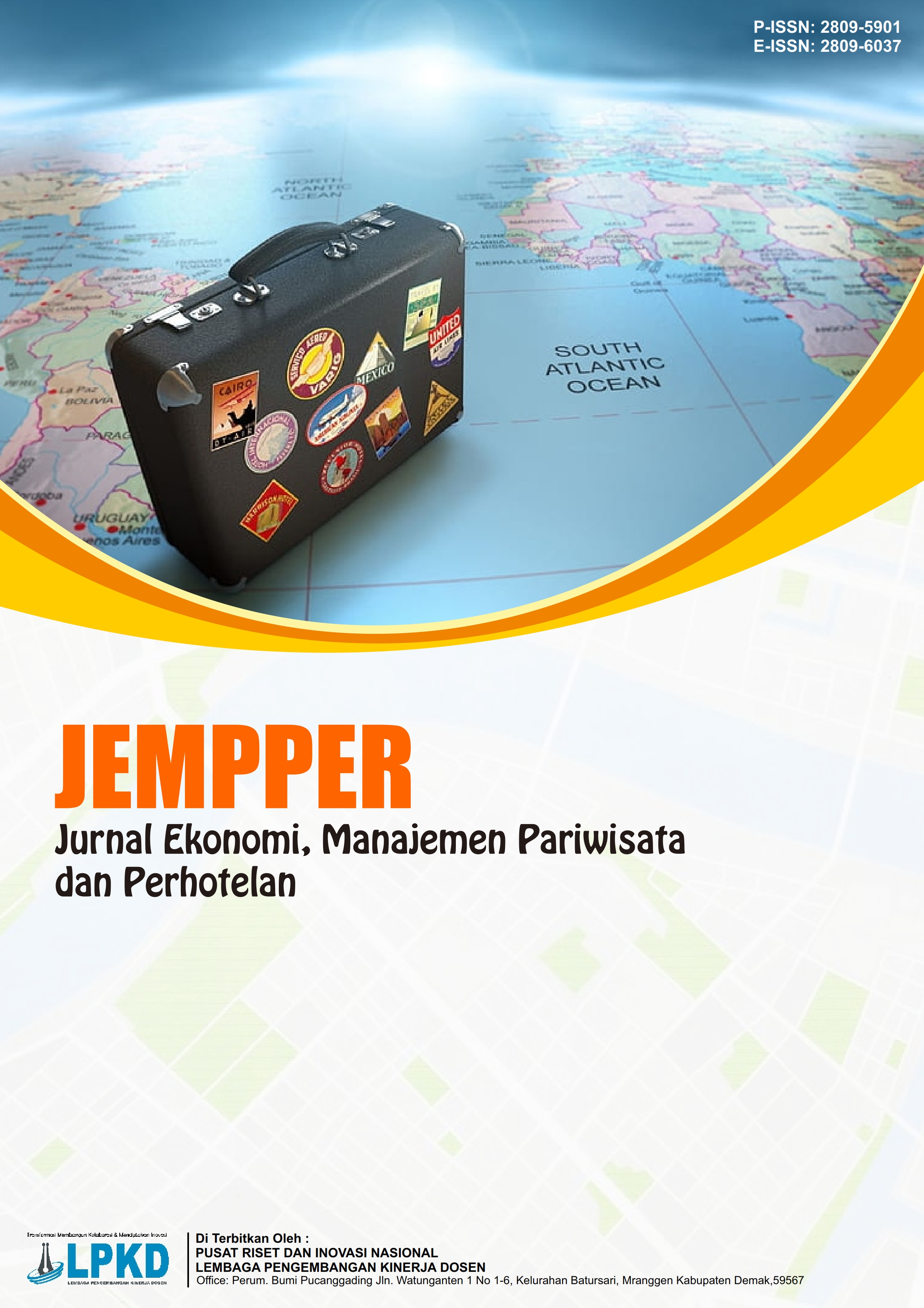Analyzing Profitability Ratios to Boost Culinary Menu Performance in Hospitality Business Development
DOI:
https://doi.org/10.55606/jempper.v4i3.5208Keywords:
Gross Profit Margin, Profitability Ratios, Restaurant Management, Return On Capital Employed, Return On SalesAbstract
This study aims to analyze the financial performance of the steak menu at Butcher Steak & Pasta Palembang using three key profitability ratios: Gross Profit Margin (GPM), Return on Sales (ROS), and Return on Capital Employed (ROCE). The method used is descriptive quantitative, with data sourced from sales records and operating costs for the period May to July 2024. This data was strengthened through observation, interviews, documentation, and literature review, thus providing a comprehensive picture of the business's profitability. The results show an average GPM of 43.73%, indicating fairly stable gross profitability. However, this value is still below the industry standard of 75%, mainly due to the high cost of goods sold for key raw materials. This indicates the need for cost control strategies, such as price negotiations with suppliers or innovation in menu engineering to increase gross profit margins. The average ROS was recorded at 43.73%, more than double the industry standard of 20%. This achievement confirms that the restaurant's operations are running efficiently, with effective cost control, resulting in a high net profit from every rupiah of sales. Furthermore, the ROCE ratio averaged 127.57%, significantly exceeding the industry benchmark of 40%. This indicates that the capital used in restaurant operations has been utilized very efficiently and has generated significant returns. Month-to-month performance fluctuations were relatively small, with a slight decline in June and a rebound in July. Overall, this study reveals that while operational efficiency and capital utilization have been excellent, there is still room for improvement in gross profitability. These findings not only provide practical recommendations for restaurant management but also enrich the literature on profitability analysis in the hospitality and culinary sectors.
References
Agung, I. G. A., Ihsan, M. T. P., & ME, I. (2024). Manajemen keuangan I.
Dewi, R. R. V. K., Hanif Hasan, S. M., Par, M. M., Riyanisma, B. I., Bandiyah, U. N., & Arch, M. (2025). Pemasaran destinasi pariwisata. Azzia Karya Bersama.
Fuad, M., Odang, H., Hasan, H., Syofya, H., Samasta, A. S., & PCC, A. (2025). Strategi keuangan bisnis: Mengelola modal untuk pertumbuhan. Cendikia Mulia Mandiri.
Halim, A. (2018). Akuntansi keuangan daerah. Jakarta: Salemba Empat.
Hasan, H., Pratiyudha, D., Mertajayano, I. M. O., Damayati, S. W., Marini, N. C. A. S., Nandana, P., & Gusma, E. M. (2025). Feasibility study of the destination of Lake Tanjung Kurung and Kampung Inggris Tempirai, PALI Regency. RIGGS: Journal of Artificial Intelligence and Digital Business, 4(2), 2823–2830. https://doi.org/10.31004/riggs.v4i2.949
Hasan, H., Sirine, H., Bakti, B., Silintowe, Y. B. R., Kojongian, P. J. C., Baali, Y., & Wekke, I. S. (2025). Pengantar manajemen pariwisata. Yayasan Tri Edukasi Ilmiah.
Hasan, H., Syahputra, M. H. I., Karo, P. K., Permatasari, M., & Khadijah, K. (2025). Social media marketing’s effect on event-based tourism development in Pagar Alam. RIGGS: Journal of Artificial Intelligence and Digital Business, 4(2), 4675–4682. https://doi.org/10.31004/riggs.v4i2.1307
Hery. (2018). Analisis laporan keuangan. Jakarta: Grasindo.
HM, M. H., Hasan, H., & Lesnussa, Y. R. A. (2023). LAC (Limit of Acceptable Change) di kawasan wisata Mandalika. Media Bina Ilmiah, 17(8), 1811–1820.
Judijanto, L., Hasan, H., & Ardhiyansyah, A. (2025). Eco-awareness and marketing strategy of Generation Z: A bibliometric study (Trans.). West Science Social and Humanities Studies, 3(6), 884–894. https://doi.org/10.58812/wsshs.v3i06.2009
Karo, P. K., & Hasan, H. (2023). Analisis kapasitas layanan destinasi wisata untuk mencapai target pasar sektor pariwisata di Kota Sabang. Jurnal Akademi Pariwisata Medan, 11(2), 83–91. https://doi.org/10.36983/japm.v11i2.493
Kasmir. (2019). Analisis laporan keuangan (Edisi kedua). Jakarta: Raja Grafindo Persada.
Kurian, G., & Muzumdar, P. (2017). Restaurant formality and customer service dimensions in the restaurant industry: An empirical study. Atlantic Marketing Journal, 6(1), 75–92.
Nazir, M. (2013). Metode penelitian. Bogor: Ghalia Indonesia.
Ninemeier, J. D., & Hayes, D. K. (2006). Restaurant operations management: Principles and practices. Upper Saddle River, NJ: Pearson Prentice Hall.
Rahmat, P. S., Hasan, H., Par, M. M., Yudiana, F. E., Ilham, B. U., Fadhillah, N., & Maharani, D. (2025). Strategi marketing yang efektif. CV Rey Media Grafika.
Sinaga, T. B. H., & Hasan, H. (2025). Analisis potensi wisata Desa Wisata Tarabunga, Kabupaten Toba, Sumatera Utara. Jurnal Visi Manajemen, 11(1), 56–69. https://doi.org/10.54066/jbe.v9i2.437
Sudirjo, F., Koynja, J. J., Hasan, H., & Sutaguna, I. N. T. (2025). Manajemen pemasaran. YPAD Penerbit.
Sugiyono. (2019). Metode penelitian kuantitatif, kualitatif, dan R&D. Bandung: Alfabeta.
Sulistiawati, E. (2022). Metodologi penelitian bisnis. Yogyakarta: Andi Offset. https://doi.org/10.31219/osf.io/c2bds
Syahputra, M. H. I., & Hasan, H. (2025). Planning and development of Burai Tourism Village in Ogan Ilir Regency, South Sumatra. Brilliant International Journal of Management and Tourism, 5(1), 1–10. https://doi.org/10.55606/bijmt.v5i1.4191
Tumpuan, H. (2021). Manajemen menu restoran. Jakarta: PT Gramedia Pustaka Utama.







